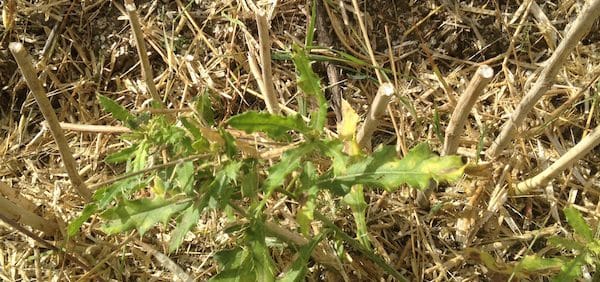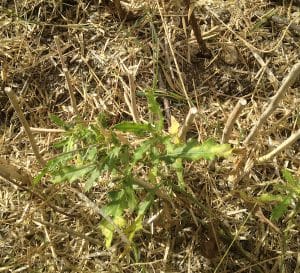Please read the most up-to-date Canola Watch article on fall weed control
Fall is a good time to control perennial and winter annual weeds, but spraying immediately after harvest may not provide the best results.
Before spraying, identify the weeds present. Are they perennials? Winter annuals? Annuals? Clubroot hosts?
Perennial weeds. Perennials such as thistles and dandelions are best controlled from mid September to early October, before a killing frost, but perennials like thistles need time after cutting to accumulate new leaf tissue to absorb herbicides. Four weeks is a minimum recommendation and six weeks is ideal if the harvest process removed most of the leaf tissue from your target weeds. Even when waiting this long, leaf surface area is still just a fraction of what it was prior to harvest. Therefore fall glyphosate rates may need to increase by 2 to 3 times over pre-harvest rates to get the same concentration of glyphosate into the plant root.
The trade off with waiting too long for leaf regrowth is losing healthy leaf tissue to frost. Without healthy leaf tissue, the herbicide can’t get translocation to the weed’s crown and storage roots where the killing can occur.
If weeds are green and the leaf tissue is still relatively pliable after a frost, growers may still have an opportunity to control perennial weeds with glyphosate or another systemic herbicide. Control can still be obtained on warm sunny days shortly after a frost if no more than 40% of the original leaf tissue is damaged. If most of the weeds are dead, herbicide uptake will be minimal and waiting is recommended.
Warmer temperatures and bright sunshine improve herbicide activity. Apply glyphosate and other systemic herbicides during the heat of day when perennial weeds are actively growing and putting energy into their roots.
Winter annuals. October until freeze up is a good time to control winter annuals such as narrow-leaved hawk’s-beard, stork’s-bill, annual sow thistle (common and spiny) and cleavers. That way you get all that have emerged. But check weed staging. Many of the post-harvest product labels have weed staging listed, and winter annuals can hit those stages before October.
With winter annuals, farmers may want to consider tank mixes as a way to prevent selection for herbicide-resistant populations. Options will be greater for fields planned for cereals next year. Herbicide options for fields planned for canola next year.
Annuals. Volunteer canola is often the most common annual weed. An option for canola volunteer management is to leave seeds undisturbed (i.e. do nothing) so they germinate in the fall or get eaten by birds and insects. Canola seeds that remain on the soil surface when the snow flies will deteriorate over the winter. If you want to do something, recent research from the University of Manitoba shows that a light pass with harrow after canola harvest stimulates the germination of volunteers and reduces seed bank additions by as much as 50 per cent.
Clubroot hosts. It can take as little as three weeks after emergence for susceptible clubroot hosts to form galls with viable spores on actively growing plants. As they decompose, those clubroot galls will release more clubroot spores back to the soil. Letting volunteer canola and other clubroot-hosting weeds (stinkweed, shepherd’s purse, flixweed and wild mustard) grow for more than three weeks after harvest could increase the clubroot spore load in a field. This goes for all fields — not just this year’s canola fields. Note that clubroot growth requires warm soils. The risk scenario described in this paragraph is, therefore, much lower with a late harvest and cool soils.
Controlling volunteers and susceptible host weeds must be done to ensure a clean break from canola in non-canola years. Allowing hosts to survive, form galls and produce more spores reduces the effectiveness of a crop rotation to allow spore load reduction in the soil.


